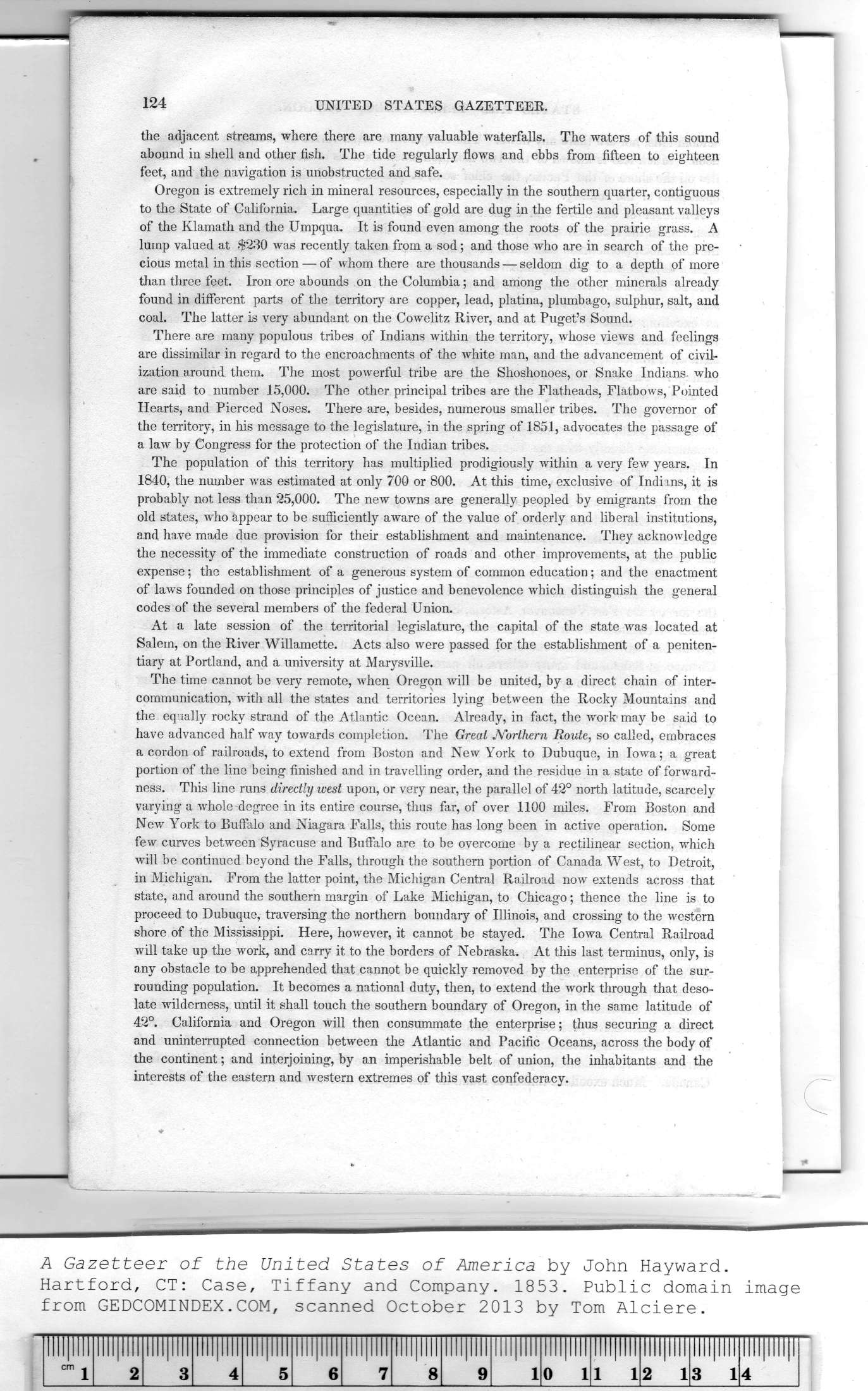|
|
Note: Ctrl and + increases the font size of the text below, Ctrl and - decreases it, and Ctrl and 0 resets it to default size.
124 UNITED STATES GAZETTEER.
the adjacent streams, where there are many valuable waterfalls. The waters of this sound
abound in shell and other fish. The tide regularly flows and ebbs from fifteen to eighteen
feet, and the navigation is unobstructed and safe.
Oregon is extremely rich in mineral resources, especially in the southern quarter, contiguous
to the State of California. Large quantities of gold are dug in the fertile and pleasant valleys
of the Klamath and the Umpqua. It is found even among the roots of the prairie grass. A
lump valued at $230 was recently taken from a sod; and those who are in search of the pre-
cious metal in this section — of whom there are thousands — seldom dig to a depth of more
than three feet. Iron ore abounds on the Columbia; and among the other minerals already
found in different parts of the territory are copper, lead, platina, plumbago, sulphur, salt, and
coal. The latter is very abundant on the Cowelitz River, and at Puget's Sound.
There are many populous tribes of Indians within the territory, whose views and feelings
are dissimilar in regard to the encroachments of the white man, and the advancement of civil-
ization around them. The most powerful tribe are the Shoshonoes, or Snake Indians, who
are said to number 15,000. The other principal tribes are the Flatheads, Flatbows, Pointed
Hearts, and Pierced Noses. There are, besides, numerous smaller tribes. The governor of
the territory, in his message to the legislature, in the spring of 1851, advocates the passage of
a law by Congress for the protection of the Indian tribes.
The population of this territory has multiplied prodigiously within a very few years. In
1840, the number was estimated at only 700 or 800. At this time, exclusive of Indians, it is
probably not less than 25,000. The new towns are generally peopled by emigrants from the
old states, 'who appear to be sufficiently aware of the value of orderly and liberal institutions,
and have made due provision for their establishment and maintenance. They acknowledge
the necessity of the immediate construction of roads and other improvements, at the public
expense; the establishment of a generous system of common education; and the enactment
of laws founded on those principles of justice and benevolence which distinguish the general
codes of the several members of the federal Union.
At a late session of the territorial legislature, the capital of the state was located at
Salem, on the River Willamette. Acts also were passed for the establishment of a peniten-
tiary at Portland, and a university at Marysville.
The time cannot be very remote, when Oregon will be united, by a direct chain of inter-
communication, with all the states and territories lying between the Rocky Mountains and
the equally rocky strand of the Atlantic Ocean. Already, in fact, the work may be said to
have advanced half way towards completion. The Great Northern Route, so called, embraces
a cordon of railroads, to extend from Boston and New York to Dubuque, in Iowa; a great
portion of the line being finished and in travelling order, and the residue in a state of forward-
ness. This line runs directly west upon, or very near, the parallel of 42° north latitude, scarcely
varying a whole degree in its entire course, thus far, of over 1100 miles. From Boston and
New York to Buffalo and Niagara Falls, this route has long been in active operation. Some
few curves between Syracuse and Buffalo are to be overcome by a rectilinear section, which
will be continued beyond the Falls, through the southern portion of Canada West, to Detroit,
in Michigan. From the latter point, the Michigan Central Railroad now extends across that
state, and around the southern margin of Lake Michigan, to Chicago; thence the line is to
proceed to Dubuque, traversing the northern boundary of Illinois, and crossing to the western
shore of the Mississippi. Here, however, it cannot be stayed. The Iowa Central Railroad
will take up the work, and carry it to the borders of Nebraska. At this last terminus, only, is
any obstacle to be apprehended that cannot be quickly removed by the enterprise of the sur-
rounding population. It becomes a national duty, then, to extend the work through that deso-
late wilderness, until it shall touch the southern boundary of Oregon, in the same latitude of
42°. California and Oregon will then consummate the enterprise; thus securing a direct
and uninterrupted connection between the Atlantic and Pacific Oceans, across the body of
the continent; and interjoining, by an imperishable belt of union, the inhabitants and the
interests of the eastern and western extremes of this vast confederacy.
|
Illllllll |
Illllllll |
llll|llll |
Hil|lfMTl|lin |
llll|llll |
llll|llll |
Illllllll |
Illllllll |
llll|llll |
Illllllll |
llll|llll |
Illllllll |
Illllllll |
!lll|llll|l |
|
cm j |
2 |
3 |
4 5 |
6 |
7 |
8 |
9 |
1 |
0 1 |
1 1 |
2 1 |
3 1 |
4 |
|
